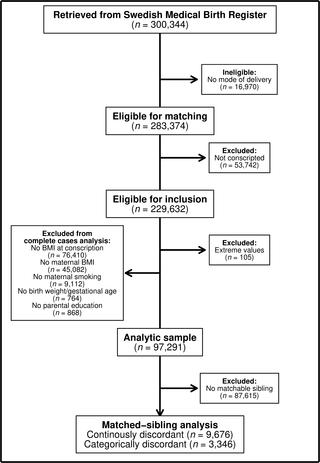Our official English website, www.x-mol.net, welcomes your
feedback! (Note: you will need to create a separate account there.)
Elective and nonelective cesarean section and obesity among young adult male offspring: A Swedish population-based cohort study.
PLOS Medicine ( IF 10.5 ) Pub Date : 2019-12-06 , DOI: 10.1371/journal.pmed.1002996 Viktor H Ahlqvist 1 , Margareta Persson 2 , Cecilia Magnusson 1, 3 , Daniel Berglind 1, 3
PLOS Medicine ( IF 10.5 ) Pub Date : 2019-12-06 , DOI: 10.1371/journal.pmed.1002996 Viktor H Ahlqvist 1 , Margareta Persson 2 , Cecilia Magnusson 1, 3 , Daniel Berglind 1, 3
Affiliation

|
BACKGROUND
Previous studies have suggested that cesarean section (CS) is associated with offspring overweight and obesity. However, few studies have been able to differentiate between elective and nonelective CS, which may differ in their maternal risk profile and biological pathway. Therefore, we aimed to examine the association between differentiated forms of delivery with CS and risk of obesity in young adulthood.
METHODS AND FINDINGS
Using Swedish population registers, a cohort of 97,291 males born between 1982 and 1987 were followed from birth until conscription (median 18 years of age) if they conscripted before 2006. At conscription, weight and height were measured and transformed to World Health Organization categories of body mass index (BMI). Maternal and infant data were obtained from the Medical Birth Register. Associations were evaluated using multinomial and linear regressions. Furthermore, a series of sensitivity analyses were conducted, including fixed-effects regressions to account for confounders shared between full brothers. The mothers of the conscripts were on average 28.5 (standard deviation 4.9) years old at delivery and had a prepregnancy BMI of 21.9 (standard deviation 3.0), and 41.5% of the conscripts had at least one parent with university-level education. Out of the 97,291 conscripts we observed, 4.9% were obese (BMI ≥ 30) at conscription. The prevalence of obesity varied slightly between vaginal delivery, elective CS, and nonelective CS (4.9%, 5.5%, and 5.6%, respectively), whereas BMI seemed to be consistent across modes of delivery. We found no evidence of an association between nonelective or elective CS and young adulthood obesity (relative risk ratio 0.96, confidence interval 95% 0.83-1.10, p = 0.532 and relative risk ratio 1.02, confidence interval 95% 0.88-1.18, p = 0.826, respectively) as compared with vaginal delivery after accounting for prepregnancy maternal BMI, maternal diabetes at delivery, maternal hypertension at delivery, maternal smoking, parity, parental education, maternal age at delivery, gestational age, birth weight standardized according to gestational age, and preeclampsia. We found no evidence of an association between any form of CS and overweight (BMI ≥ 25) as compared with vaginal delivery. Sibling analysis and several sensitivity analyses did not alter our findings. The main limitations of our study were that not all conscripts had available measures of anthropometry and/or important confounders (42% retained) and that our cohort only included a male population.
CONCLUSIONS
We found no evidence of an association between elective or nonelective CS and young adulthood obesity in young male conscripts when accounting for maternal and prenatal factors. This suggests that there is no clinically relevant association between CS and the development of obesity. Further large-scale studies are warranted to examine the association between differentiated forms of CS and obesity in young adult offspring.
TRIAL REGISTRATION
Registered as observational study at ClinicalTrials.gov Identifier: NCT03918044.
中文翻译:

青少年成年男性后代的选择性和非选择性剖宫产与肥胖:一项基于瑞典人群的队列研究。
背景技术以前的研究表明,剖宫产(CS)与后代超重和肥胖有关。但是,很少有研究能够区分选择性和非选择性CS,这可能在其孕产妇风险状况和生物学途径上有所不同。因此,我们旨在检查与CS的分娩方式不同和成年后肥胖风险之间的关系。方法和研究结果使用瑞典人口登记表,对一组1982年至1987年之间出生的97,291名男性进行了追踪,从出生到入伍(如果年龄在2006年之前入伍)(年龄在18岁以下)。身体质量指数(BMI)的组织类别。母婴数据来自《医疗出生登记》。使用多项式和线性回归对关联进行评估。此外,进行了一系列敏感性分析,包括固定效应回归以解决全兄弟之间共享的混杂因素。应征者的母亲平均在分娩时的年龄为28.5岁(标准差4.9),孕前BMI为21.9(标准差3.0),并且41.5%的应征者中至少有一名父母具有大学学历。在我们观察到的97,291名应征入伍者中,有4.9%为肥胖(BMI≥30)。在阴道分娩,选择性CS和非选择性CS之间,肥胖的患病率略有不同(分别为4.9%,5.5%和5.6%),而BMI在各个分娩方式中似乎是一致的。我们没有发现非选择性或选择性CS与年轻成年肥胖之间的关联的证据(相对风险比0.96,置信区间95%0.83-1.10,p = 0.532和相对风险比1.02,置信区间95%0.88-1.18,p = 0.826分别与考虑孕产妇的BMI,孕产妇的糖尿病,孕产妇的高血压,孕产妇的吸烟,均等,父母教育,孕产妇的年龄,孕龄,根据孕龄标准化的出生体重后的阴道分娩相比先兆子痫。与阴道分娩相比,我们没有发现任何形式的CS和超重(BMI≥25)之间存在关联的证据。同级分析和一些敏感性分析并没有改变我们的发现。我们研究的主要局限性在于,并非所有应征入伍者都可以使用人体测量学和/或重要混杂因素(保留42%),并且我们的队列仅包括男性人群。结论我们没有证据表明,考虑母亲和产前因素时,年轻男性应征者中选择性或非选择性CS与年轻成年肥胖之间存在关联。这表明CS与肥胖的发展之间没有临床相关的关联。有必要进行进一步的大规模研究,以检查年轻成年后代中CS的不同形式与肥胖之间的关系。试验注册在ClinicalTrials.gov上注册为观察性研究标识符:NCT03918044。结论我们没有证据表明,考虑母亲和产前因素时,年轻男性应征者中选择性或非选择性CS与年轻成年肥胖之间存在关联。这表明CS与肥胖的发展之间没有临床相关的关联。有必要进行进一步的大规模研究,以检查年轻成年后代中CS的不同形式与肥胖之间的关系。试验注册在ClinicalTrials.gov上注册为观察性研究标识符:NCT03918044。结论我们没有证据表明,考虑母亲和产前因素时,年轻男性应征者中选择性或非选择性CS与年轻成年肥胖之间存在关联。这表明CS与肥胖的发展之间没有临床相关的关联。有必要进行进一步的大规模研究,以检查年轻成年后代中CS的不同形式与肥胖之间的关系。试验注册在ClinicalTrials.gov上注册为观察性研究标识符:NCT03918044。有必要进行进一步的大规模研究,以检查年轻成年后代中CS的不同形式与肥胖之间的关系。试验注册在ClinicalTrials.gov上注册为观察性研究标识符:NCT03918044。有必要进行进一步的大规模研究,以检查年轻成年后代中CS的不同形式与肥胖之间的关系。试验注册在ClinicalTrials.gov上注册为观察性研究标识符:NCT03918044。
更新日期:2020-01-14
中文翻译:

青少年成年男性后代的选择性和非选择性剖宫产与肥胖:一项基于瑞典人群的队列研究。
背景技术以前的研究表明,剖宫产(CS)与后代超重和肥胖有关。但是,很少有研究能够区分选择性和非选择性CS,这可能在其孕产妇风险状况和生物学途径上有所不同。因此,我们旨在检查与CS的分娩方式不同和成年后肥胖风险之间的关系。方法和研究结果使用瑞典人口登记表,对一组1982年至1987年之间出生的97,291名男性进行了追踪,从出生到入伍(如果年龄在2006年之前入伍)(年龄在18岁以下)。身体质量指数(BMI)的组织类别。母婴数据来自《医疗出生登记》。使用多项式和线性回归对关联进行评估。此外,进行了一系列敏感性分析,包括固定效应回归以解决全兄弟之间共享的混杂因素。应征者的母亲平均在分娩时的年龄为28.5岁(标准差4.9),孕前BMI为21.9(标准差3.0),并且41.5%的应征者中至少有一名父母具有大学学历。在我们观察到的97,291名应征入伍者中,有4.9%为肥胖(BMI≥30)。在阴道分娩,选择性CS和非选择性CS之间,肥胖的患病率略有不同(分别为4.9%,5.5%和5.6%),而BMI在各个分娩方式中似乎是一致的。我们没有发现非选择性或选择性CS与年轻成年肥胖之间的关联的证据(相对风险比0.96,置信区间95%0.83-1.10,p = 0.532和相对风险比1.02,置信区间95%0.88-1.18,p = 0.826分别与考虑孕产妇的BMI,孕产妇的糖尿病,孕产妇的高血压,孕产妇的吸烟,均等,父母教育,孕产妇的年龄,孕龄,根据孕龄标准化的出生体重后的阴道分娩相比先兆子痫。与阴道分娩相比,我们没有发现任何形式的CS和超重(BMI≥25)之间存在关联的证据。同级分析和一些敏感性分析并没有改变我们的发现。我们研究的主要局限性在于,并非所有应征入伍者都可以使用人体测量学和/或重要混杂因素(保留42%),并且我们的队列仅包括男性人群。结论我们没有证据表明,考虑母亲和产前因素时,年轻男性应征者中选择性或非选择性CS与年轻成年肥胖之间存在关联。这表明CS与肥胖的发展之间没有临床相关的关联。有必要进行进一步的大规模研究,以检查年轻成年后代中CS的不同形式与肥胖之间的关系。试验注册在ClinicalTrials.gov上注册为观察性研究标识符:NCT03918044。结论我们没有证据表明,考虑母亲和产前因素时,年轻男性应征者中选择性或非选择性CS与年轻成年肥胖之间存在关联。这表明CS与肥胖的发展之间没有临床相关的关联。有必要进行进一步的大规模研究,以检查年轻成年后代中CS的不同形式与肥胖之间的关系。试验注册在ClinicalTrials.gov上注册为观察性研究标识符:NCT03918044。结论我们没有证据表明,考虑母亲和产前因素时,年轻男性应征者中选择性或非选择性CS与年轻成年肥胖之间存在关联。这表明CS与肥胖的发展之间没有临床相关的关联。有必要进行进一步的大规模研究,以检查年轻成年后代中CS的不同形式与肥胖之间的关系。试验注册在ClinicalTrials.gov上注册为观察性研究标识符:NCT03918044。有必要进行进一步的大规模研究,以检查年轻成年后代中CS的不同形式与肥胖之间的关系。试验注册在ClinicalTrials.gov上注册为观察性研究标识符:NCT03918044。有必要进行进一步的大规模研究,以检查年轻成年后代中CS的不同形式与肥胖之间的关系。试验注册在ClinicalTrials.gov上注册为观察性研究标识符:NCT03918044。











































 京公网安备 11010802027423号
京公网安备 11010802027423号